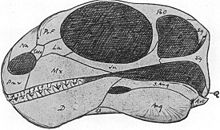| Chainosauria Temporal range:
| |
|---|---|

| |
| Skull of Galepus, a 'dromasaur' | |

| |
| Skull of Eodicynodon, a dicynodont | |
| Scientific classification | |
| Domain: | Eukaryota |
| Kingdom: | Animalia |
| Phylum: | Chordata |
| Clade: | Synapsida |
| Clade: | Therapsida |
| Suborder: | †Anomodontia |
| Clade: | †Chainosauria Nopsca, 1923 |
| Subtaxa | |
Chainosauria is a large and speciose clade of anomodont therapsid that includes the highly diverse dicynodonts and a small number of closely related basal genera (to the exclusion of Venyukovioidea and more basal anomodonts)—although the total composition and taxonomic scope of Chainosauria is in flux. Chainosauria was named in 1923 to group together the dicynodonts and their close relatives, namely three small anomodont genera from South Africa (Galechirus, Galeops, and Galepus) that made up the now defunct group 'Dromasauria'. The name soon fell into disuse, however, as it was functionally replaced by Anomodontia. Chainosauria was later revived cladistically in 2009, preserving the association of dicynodonts and the 'dromasaurs' and has since served in effect as both a cladistic and a biogeographic counterpart to the Laurasian venyukovioids, with early chainosaurs appearing to have been a Gondwanan radiation.
Other basal anomodonts, the anomocephaloids and Patranomodon, have also sometimes been recovered as chainosaurs, and so the contents and relationships of early chainosaurs are not resolved. As such, autapomorphies (unique defining traits) that unite chainosaurs are difficult to determine with certainty. Early chainosaurs are much more lightly built and slender than dicynodonts. However, in general their skulls are proportionally more dicynodont-like than more basal anomodonts. Furthermore, while the first chainosaurs lacked the characteristic tusks and beaks of dicynodonts and had complete rows of teeth, the sliding jaw-joint and jaw musculature of dicynodonts had first evolved in earlier chainosaurs (namely the dicynodont-adjacent genus Galeops), and their teeth were simplified and reduced (apart from anomocephaloids).
